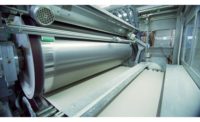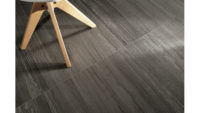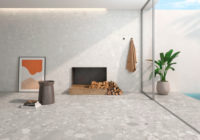We sat down with a handful of industry professionals to discuss Gauged Porcelain Tiles (GPT) and Gauged Porcelain Tile Panels (GPTP), how they’re handled and installed, and the best ways to approach any issues while utilizing the materials.
Over the last five years, Gauged Porcelain Tile (GPT) has become a well-known term in this industry. Although many people may be confused by the difference between GPT and Gauged Porcelain Tile Panels (GPTP), don’t fret — you are not alone. GPT has been defined as tiles that measure 1 x 1 meter (~36 x 36 inches) or smaller, while GPTP are equal to or larger than 1 x 1 meter.
Prior to being coined GPT, these tiles were widely referred to as “Thin Porcelain Tile” (TPT), but since sizes have continued to grow, as well as thicknesses, a more updated term was created to encompass all types of these materials.
In 2017, after more than four years of cross-disciplinary industry collaboration and 4,000 hours of research, the Tile Council of North America (TCNA), which is responsible for devising material and installation standards for the tile industry, unveiled two new standards for the materials — ANSI A137.3, the American National Standard Specifications for Gauged Porcelain Tiles and Gauged Porcelain Tile Panels/Slabs, and its companion, ANSI A108.19, Interior Installation of Gauged Porcelain Tile and Gauged Porcelain Tile Panels/Slabs by the Thin-Bed Method bonded with Modified Dry-Cement Mortar or Improved Modified Dry-Set Cement Mortar. The standards use the term “gauged” to cover a range of precise thicknesses that can carry different loads and be used in different ways, taking a similar approach to standardized wire gauged and gauged sheet metal. Two classes of gauged tile products are defined — those for wall applications, from 3.5 to 4.9 mm in thickness, and those for floor applications, from 5 to 6.5 mm in thickness.
ANSI A137.3 standardized the minimum required properties for the products themselves, while ANSI A108.19 standardized the methodologies for installing the products in interior installations by the thin-bed method with specific mortars.
According to executive director of the TCNA, Eric Astrachan, “Installers especially were asking for standards to allow for installation practices to be developed based on consistent tile properties,” which partially prompted the standards’ creation.
Now, less than two years after the introduction of these standards, the work that went into creating them has seen a huge payback, as the GPT/GPTP segment has seemingly exploded. Tile manufacturers continue to push boundaries when it comes to sizes, as well as the types of designs they’re embossed with, while adhesive manufacturers have been vehemently pursuing the new category to aptly provide products to install these materials.
To learn more about how GPT/GPTP has affected the market, we spoke with a handful of industry professionals, who shed some light on the impact the materials have had since their introduction. “Porcelain panels offer the superior technical features of porcelain in a size that, until recently, was exclusive for quarry products like marble and stone,” said Guilia Giberti, head of communications at StonePeak Ceramics Inc. “Additionally, GPT is available in a wide range of looks that span from the most coveted marbles and onyxes to classic and modern stones, and also concrete looks and full colors. This combination of physical and mechanical characteristics, great aesthetics and huge format opens a new, virtually limitless world of design possibilities for designers and architects.
“In fact, GPT is extremely strong, durable, scratch-resistant, easy to maintain and clean, UV-stable and much more; therefore, it can be installed virtually anywhere, indoors and outdoors, in both commercial and residential applications,” Giberti went on to explain. “Visually, the large format allows a clean, seamless look that breaks free from the optical interruptions of joints to offer the aesthetics of the material in all its beauty. Also, GPT is a green product, as is all high quality porcelain, since it is made of all natural raw materials without added chemicals and artificial bindings.”
“The designers love the look of these panels installed,” said Will White, director of technical communications and training at Custom Building Products. “The Gauged Porcelain Tile Panels [GPTP] are something completely different than traditional tile and provide many design options to the owner. Because some of these panels are thinner than traditional tiles, they allow tile-over-tile installation, which saves time and money for the remodel/rehab projects. For the contractor, these materials offer an opportunity to separate themselves from competitors in their markets and avoid bidding wars.”
“We are still achieving significant year-over-year growth in the porcelain tile panel category, as we have for the last five years,” added Noah Chitty, director of technical services at Crossville, Inc. “We are definitely seeing increased growth of the total category as well from what we see at tradeshows and industry publications like yours.”
Gianni Ruberti, the Northeast sales representative for Mirage, who observes trends oversees and in the U.S., also agrees that the GPT is a growing segment. “The initial hesitation of the market has been won over progressively by the many advantages of porcelain slabs,” he said.
When it comes to sizes of GPT and GPTP, larger formats have been stealing the spotlight, with some panels that stand taller than 10 feet. “The initial offering was 48 x 96 inches and then 48 x 110 and 63 x 126 inches, with thicknesses ranging from 1/4- to 1/2-inch,” said Ruberti. “The 48- x 110-inch panels addressed the potential issue of the 8-foot wall and works great with 48- x 48-inch floors. For larger areas, the 63- x 126-inch format is the size of choice.”
“Our biggest seller in GPT is still the full-size of 1 x 3 meters, although since we have a cut-to-size program, we have seen growth in that as well for smaller sizes like 1 x 1 and 0.5 x 1 meter,” said Chitty. “For our traditional thickness materials, 12- x 24-inch is still king, but 18- x 36- and 24- x 36-inch formats are increasing in use. The 24- x 48-inch format seems to be requested in the market and we have collections with that size, but the others are still volume-wise, superior.”
When it comes to specifying GPT and GPTP, architects and designers seem to be on board, but a different perspective is taken by many installers, who are hesitant to even touch the material because of its sheer size. “Designers have always been on board for the most part since the beginning; the hurdle has been getting them installed correctly and for a reasonable cost,” said Chitty. “This factor is not near the hurdle today as it was two or three years ago. I believe this is due to the significant amount of training we, along with others in the industry, have provided, joined with the A108.19 installation standard, which provides much more stability and rules to this side of the equation. This, without question, has resulted in less challenges and road blocks from the installation side.”
“They are easy to specify, but can be challenging to maintain through completion in some cases,” said White, who takes the same stance as Chitty. “What we have seen in this emerging market is a lot of interest in concept/design and the material costs have been fairly reasonable to gain entry into the project specifications. However, we have seen challenges in maintaining the specification for a few reasons. Qualified labor is available for bidding the projects, especially in major metropolitans; however, in some cases, labor bids have been inflated, which has driven the cost of the panels to removal from the specification and reselection typically in the value engineering stages. Training efforts provided by panel manufacturers and Custom Building Products have been underway for more than four years now and the National Tile Contractors Association is now sponsoring these types of travel training programs.
“ANSI A108.19 is the new installation standard covers the installation process, which is completely different than tradition tile and will require new tools, new methods, transportation changes, storage changes and training requirements for crew members,” White went on to explain. “Other situations, the material/install bid have been accepted and contracted, but due to over-sight regarding site logistics and delivery, the panels have been returned for cutting in smaller format to local fabrication shops or scraped and reselected altogether.”
Ruberti piggybacked Chitty and White’s comments, adding how distributors have to adapt as well. “Architects and designers love porcelain slabs, however, some distributors, who are new to this, are not yet equipped or used to handling A-frames or extra-large crates,” he said. “Some fabricators are also still unfamiliar with the fabrication process. From an installation perspective, they pose a couple of extra challenges and again you will see some contractors that are used to this and some that are new to this, who are going through the same learning curve.”
When it comes to installing GPT and GPTP, the rules aren’t much different than for a 12- x 24-inch tile, but ensuring the surface is flat is one of the most important factors. “The key to a successful installation of large porcelain slabs is that the surface must be flat and true, with no irregularities,” said Ruberti. “The TCNA has highlighted and defined the acceptable parameters for surface preparation in the TCNA Handbook.”
“Surface preparation is crucial to all finish material installations to ensure long-lasting installations, especially GPTP,” added White. “While the industry standard tolerance is the same for a 12- x 24-inch tile as it is for a 5- x 10-foot gauged porcelain tile panel — which is maximum allowable variation is 1/8-inch in 10 feet and no more than 1/16-inch in 24 inches from the required plane — one major difference is there is no way to hide or manage deficiencies on tolerance with a GPTP. ANSI A108.19 translates into: ‘You must get your substrate’s flatness within tolerance before you begin your installation and you should include your surface preparation costs in a separate bid so you get paid for the prep work.’”
Chitty agreed with White, but pointed out how bids don’t always match the type of work that’s required from the installer, which is slowly changing. “Surface preparation is very important and necessary, but it is also important to point out that the requirements for installing GPT and GPTP are exactly the same, not more, as ANSI requires for all tiles over 15 inches on any side,” he said. “The problem has always been getting the bids so that all are factoring this in accordingly and equally, and educating the architects and designers about the need for surface prep. For too long, we have relied, incorrectly, on other trades to provide the flatness of substrate that is required. But, more recently, I think we are doing a good job to turn this corner and educate those that must specify and bid this correctly, and most importantly, making sure that installers or whichever trade is doing it are paid for this work.”
When determining which types of adhesives and installation products to use with GPT and GPTP, White outlined which products work best for certain applications, including floors and walls. For floor installations, he recommends using self-leveling underlayments (SLUs), as they are much more efficient for final flatness than trowel-applied materials. For wall installations, the use of an engineered, cement-based patching compound designed for bond, build out and cure is “the preferred material of choice.”
“Membranes are strongly recommended, not only for waterproofing or crack isolation, but to assist in managing diffusion or limiting water absorption from the bonding mortar into the substrate, which extends open time of the mortar to ensure maximum wet mortar transfer between the back of the GPTP and the substrate the contractor is bonding to,” said White. “Fasteners are not required for use to install bonded GPTP inside or outside. A cementitious mortar designed for installation works very well and will not let the GPTP fall off the wall assembly when installed correctly. Mechanical fasteners can be required in some cities and municipalities, so confirming this in the planning phase when installing GPTP on exterior veneers is critical. There are many options for mechanical fasteners and can be an expensive installation method. However, there are fasteners designed to work with bonding mortars and can be a successful process for exterior bonded GPTP veneers, which is where we typically see them used together.
“Lastly, selecting a grout for filling the small space between the GPTP is as simple as selecting a grout for any time installation by using the service rating of the project,” he went on to say. “Some tile/panel manufacturers require the use of an epoxy grout for commercial floor installation and most recommend using silicone on exterior veneers in place of grout.
In the beginning, as in this case, it’s in the end. Always work with the tile/panel manufacturer and the installation systems manufacturer to ensure your specification is the right one for your project.”
Although there have been introductions of new products more recently that are catered to GPT and GPTP, Chitty said other products were utilized prior to their creation, which installers learned to properly adapt. “There were mortars that we used very successfully in the beginning that were not designed for these large tiles specifically,” he said. “We were able to accomplish what we needed by manipulating to the high end of the water ratio and using techniques and best practices to control open time and flow (to get coverage). The fact that now we have mortars from many major manufacturers specifically made to control these parameters and others to make porcelain tile panel installation easier and more successful says so much about our industry’s ability to innovate and provide solutions to problems. We don’t need grouts to have different capabilities for the most part, but grouts continue to innovate for colorfastness and ease of use, and it is important to understand the different types and what they bring to the installation.”
“Gauged porcelain panels have unique and specific challenges, from the need for more open time for cement-based mortars to resin-backed products that may require reactive adhesives,” added White. “Thankfully in 2017, the new ANSI A137.3 GPTP Material standard was approved and published to help guide the North American markets for procurement of products that meet these standards and will perform for a lifetime. Most GPTP Material will allow the use of a cement-based mortar, but not just any mortar type or class will do. An improved, modified dry set mortar meeting the ANSI A118.15 standard should be used for higher bonds strengths, reduced absorption rates and higher flexural capacity to sustain minor movement from building structures and thermal cycling of the panels. Grouts should be selected as they should for all tile applications, by defining the service requirements of the project. Most grouts work fine with the panels even when they are only 3-mm-thick. Silicone sealants have always been important to a tile assembly to allow movement where required; they play a larger role with these GPTP and often are the only material specified for vertical/exterior applications.”
Since these materials present new challenges for architects, designers, contractors and installers, education is a critical factor. “Get in touch with people who have knowledge and experience of the product,” said Giberti. “They can give great advice and help the installation go smoothly.”
White, Ruberti and Chitty agree, adding in their tidbits of advice to designers and installers who aren’t well-versed with using GPT and GPTP. “Find a panel manufacturer and setting material manufacturer that know the standards and their products meet and exceed the requirements of the standards,” said White. “Find a contractor that has the training, tools and a good track record. Ask for support throughout the process, including onsite installation guidance, and do not forget the warranty.”
“For designers, I recommend imagining all possibilities that go beyond floor and wall or facade installation,” said Ruberti. “There are many options — from tables, seats, benches to light fixtures. It is truly a product where the designer’s imagination can create many new solutions that we did not yet envision while developing this technology.
“For the installers, I would recommend to be well-informed and to learn how to handle and install these products,” he added. “Every manufacturer’s website features installation videos with recommendations and detailed instructions. Based on the jobsite, plan ahead of time what can be done at the fabricator’s location and what can be done onsite.”
“If you intend to use the materials, especially in their full-size formats, it is important as a designer to make sure that qualified labor is specified if you want your vision realized and you want it done correctly (A108.19 has this language),” said Chitty. “If you are an installer, you need to get training and understand the right tools and techniques described in ANSI A108.19. If you think a 10-foot-long, 3- to 5-foot-wide piece of porcelain that is 1/8- to 1/4-inch-thick is just like that other tile you have been using for the last 30 years, you are wrong. It is not overly complicated or difficult, but it’s not a 12- x 24-inch tile, and if you want to be successful and profitable, understand what you do know, and more importantly, what you don’t.”







